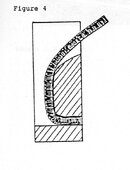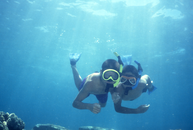Actually, as a long-time snorkeler, I prefer upon surfacing from a surface dive to start the exhalation while looking up, and the snorkel is therefore clear when the head breaks the surface. It's easier than the "blow clear" after surfacing.Serious snorkelers avoid purge valves. The old style blow clear upon surfacing is still the best way to go for a diver. Kids just floating at the surface use purge valves.
On a slightly different note, I still have my old Scubapro Shotgun snorkels, which actually kept dry when waves come into the snorkel tube because of the design of the clearance mechanism. It had a separate tube that the water followed and was expelled through a non-return valve. I used this snorkel on a 16 mile swim in the 1980 as a fundraiser for a small girl who had a fatal disease. I was at the time Finswimming Director for the Underwater Society of America, trying to get finswimming recognized as a sport in and of itself. In the pool, we used a front-mounted snorkel, but at that time I found the Scubapro Shotgun snorkel best for open water. Now, there are many more designs to choose from, many of which do not incorporate any restriction in breathing resistance other than the length of the tube.
One other snorkel that I choose was the U.S. Divers Company Impulse snorkel, which we used on a trip years ago to Maui, Hawaií. Below is a photo of my two sons with their Impulse snorkels. That one had a dome on the top, which fed water out a non-return ring at the top of the snorkel.
Both of these snorkels did not interfere with breathing resistance, but effectively kept water from wave action out of the snorkel.
In the 1980s there were no front-mount snorkels available commercially, and so European competitive finswimmers made their own. Here's some diagrams that illustrate them.
SeaRat






